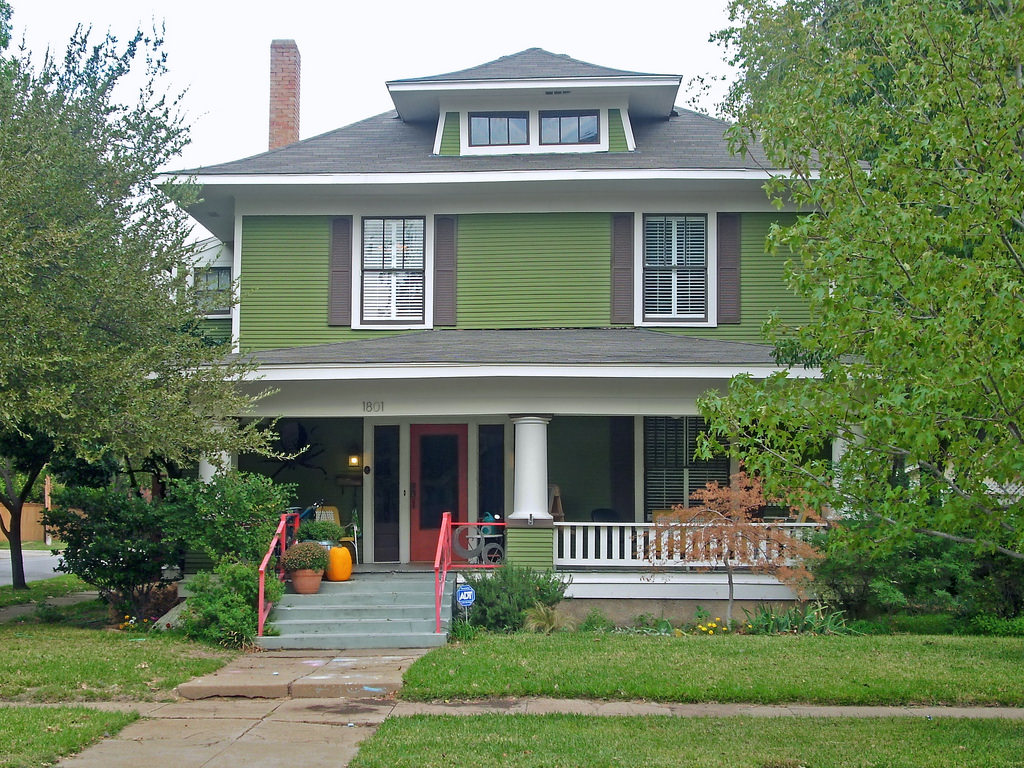The American Foursquare, a familiar sight in many historic neighborhoods, remains a popular housing choice today. Its blend of practicality, affordability, and enduring style continues to resonate with homeowners over a century after its rise to prominence. Emerging in the late 19th and early 20th centuries, the Foursquare offered a refreshing alternative to the ornate Victorian homes of the era, appealing to a growing middle class seeking efficient and comfortable living spaces.
Decoding the Foursquare’s Enduring Appeal
The Foursquare’s enduring popularity likely stems from its unique combination of classic design and practical functionality. Let’s explore the key elements that define this iconic American home:
Core Architectural Features
The Foursquare’s distinctive features make it easily recognizable:
- Shape: A two-story, cubic structure, often with a perfectly square footprint, although rectangular variations exist. This efficient design maximizes interior space on smaller lots.
- Roof: A prominent hipped roof, sloping inwards from all four sides. This design efficiently sheds rain and snow, contributing to the home’s durability. Dormers are a common addition, increasing attic space and natural light.
- Porch: A welcoming front porch, often spanning the full width of the house, provides a space for relaxation and socializing. Some Foursquares feature porches that wrap around the side, further extending the outdoor living area.
- Windows: Large, double-hung wood windows, often arranged symmetrically, allow ample natural light to fill the interior.
- Layout: A symmetrical façade with a centered front door and windows creates a balanced and orderly appearance. Inside, a central hallway connects four main rooms on each floor, optimizing flow and functionality. Built-in features like fireplaces with shelves and bookcases add to the home’s charm and practicality. If adding a touch of farmhouse chic to your living room is on your mind, you simply cannot go wrong with a beautiful fireplace with shelves.
- Interior: The typical layout includes four spacious rooms per floor arranged around a central hallway and staircase. Original built-in cabinets and fireplaces are frequently found, adding character. The adaptable layout lends itself well to modern open-concept renovations, blending old-world charm with contemporary living.
A Historical Perspective
The Foursquare’s history is as interesting as its architecture. Its rise in popularity in the early 1900s coincided with the growth of the American middle class and suburban development. These homes were frequently sold as pre-cut kits through mail-order catalogs, making homeownership more accessible. Regional variations developed, reflecting different climates, local styles, and available materials. This “kit home” aspect resonates with today’s DIY ethos, as many Foursquare owners enjoy restoring and renovating these classic homes.
Advantages and Disadvantages for Modern Living
The Foursquare offers several advantages for today’s homeowners:
- Spacious Rooms: Provides ample living space for families of all sizes.
- Classic Design: A timeless aesthetic that maintains curb appeal.
- Adaptable Layout: Easily updated to suit modern lifestyles and preferences.
- Solid Construction: Built to last, often boasting surprising structural integrity.
However, potential drawbacks should also be considered:
- Boxy Shape: While classic, the boxy design can feel limiting to some.
- Maintenance: Older homes typically require more upkeep.
- Smaller Closets: Closet space may be limited compared to newer homes.
- Limited Natural Light (Potentially): Some Foursquares may require strategic renovations to maximize natural light.
Identifying the Foursquare: A Comprehensive Guide
So, what truly distinguishes a Foursquare? While variations exist, the following key elements generally define this architectural style:
- The Cubic Form: Visualize a two-story box — this is the fundamental shape, maximizing interior space within a compact footprint.
- The Hipped Roof: Sloping downwards on all four sides, this roof type effectively sheds water and adds to the symmetrical aesthetic.
- The Welcoming Porch: A generous porch, often spanning the entire front façade, serves as an extension of the living space.
- The Symmetrical Facade: A balanced and centered design, with the front door and windows aligned for a classic, ordered look.
- The Four-Room Layout: Each floor typically features four rooms arranged around a central hall.
Research on architectural history is ongoing, and some debate exists among experts regarding specific Foursquare details. However, the characteristics described above are generally accepted as defining features.
Craftsman vs. Foursquare: Distinguishing Features
Both the Craftsman and Foursquare styles emerged from the Arts & Crafts movement, sharing a reaction against Victorian-era ornateness. However, distinct differences exist:
| Feature | Craftsman | Foursquare |
|---|---|---|
| Shape | Varied, often low-slung, rectangular | Boxy, square, upright |
| Roof | Low-pitched gable or hipped | Steep-pitched hipped or pyramidal |
| Porch | Prominent, often full-width, detailed | Simpler, full or half-width |
| Windows | Multiple panes, often casement | Double-hung wood |
| Interior | Open plan, natural materials | Symmetrical, more traditional |
| Emphasis | Handcraftsmanship, nature | Practicality, efficiency |
While these are general guidelines, some homes blend elements of both styles. For example, a Foursquare might incorporate Craftsman details like exposed rafters or decorative brackets. A Gambrel house is one of the most impressive architectural homes you can find.
Understanding the Four Square Layout: Form & Function
The Foursquare layout is characterized by its efficient use of space. Imagine each floor divided into four roughly equal rooms, arranged around a central hallway. This straightforward design maximizes usable living area and creates distinct spaces for different functions. While the classic layout is fairly traditional, its sturdy structure and spacious rooms offer significant potential for modern open-concept renovations.
The Four Square’s popularity stemmed from its affordability, practicality, and adaptability. It provided a sensible alternative to larger, more elaborate homes, fitting comfortably on smaller lots and accommodating growing families.
While the traditional Four Square layout features four rooms per floor, modern adaptations often involve reconfiguring spaces to create open floor plans and better suit contemporary lifestyles. This adaptability is a key factor contributing to the Foursquare’s continued relevance in the housing market. Ongoing research continues to explore the nuances of architectural trends and how styles like the Four Square have evolved and influenced modern design.
- How to Remove Water Stains from Fabric: A Complete Guide - April 26, 2025
- How to Get Motor Oil Out of Clothes: Proven Methods & Expert Tips - April 26, 2025
- How to Get Deodorant Out of Black Shirts: Easy Stain Removal Guide - April 26, 2025










